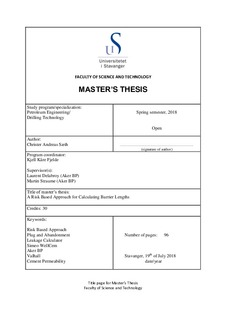| dc.description.abstract | NORSOK D-010 and other standards gives a fixed length of cement for permanently plugging of wells. These lengths are not based on scientific research, but on old practice. A fixed length leads to a shift in focus from where the barriers in a well are most effective, to where in a well this length can be placed.
In the shallow zones of the Valhall field, the interval of easily verifiable external cement is shorter than what is required by the NORSOK D-010 standard. To be in accordance with the standard, the only available option might be section milling, which is an expensive and HSE critical operation. Therefore, it is desirable to look at other options. One such option is the methodology presented by Godøy et al. [1], where the length of cement is based on estimated leakage rates through the barrier. An accepted well is used as a reference, where the estimated leakage rates are set as the Upper Accepted Case (UAC). This reference case is from another operator on the Norwegian Continental Shelf (NCS), where Aker BP does not have control over the data. Because operators are held accountable for the wells they abandon, data control is essential. In this thesis, a new reference case for Aker BP is defined.
Cement is to some extent a porous medium and leakage will occur in the same way as natural formations have leakages. By looking at an accepted single barrier covering the reservoir at Valhall, and calculating the theoretical leakage rate across this barrier, the reference case that defines the UAC is set. The leakage rate is found with the use of the Darcy’s law based simulation program Simeo WellCem. The new Aker BP reference case can then be used to estimate equivalent cement lengths in other parts of the well, or other wells.
At shallower depths, the pressure and temperature conditions will be less severe, while the cement will typically be of lower quality. To compare these conditions to the reference case, cement samples from the shallower depths are tested to get realistic permeability data, and the corresponding leakage rates compared to the UAC. In the studied case, it was seen through leakage modeling that one could reduce the length requirements compared to the 2 x 30 meters defined by NORSOK D-010 (verified annular cement). The presented risk based methodology has a more scientific foundation and combines testing of leakage through cement with theoretical models for leakage. This approach can be used for dispensation request, or to discover and mitigate risk where longer barriers than these 2 x 30 meters are needed to achieve the UAC. | nb_NO |
